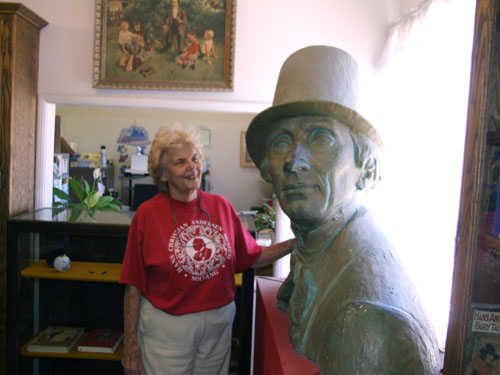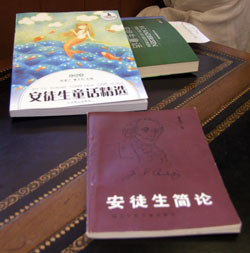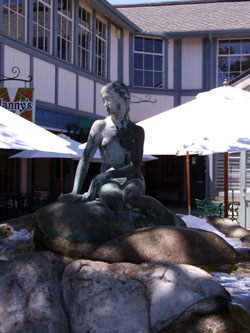
By Donald H. Harrison
SOLVANG, California –This famed Danish village in central California made bookseller Kathy Mullins and her late husband, Gary, an aerospace engineer, feel welcome after a life in which they crisscrossed the country on assignment for Boeing Aircraft.

Their business selling books to tourists and to locals grew, and the Mullins, of Irish, Scotch and German backgrounds, came to love the Danish culture that surrounded them. At first, they stocked books to sell by famed children’s writer Hans Christian Andersen because he is one of the most famous Danes the world has known. Mullins said she believes his stories have been translated into more languages than any other writing in the world, with the exception of the Holy Bible.
But the more at home the couple felt, the more they wanted to show their appreciation to their adopted town. In 1989 they started a small non-profit museum dedicated to Hans Christian Andersen, for which they prepared by going on buying trips to the East Coast of the United States, to England, and, of course, to Denmark, where they snapped up as many Andersen books and articles of memorabilia as they could afford.
The museum occupies an upstairs space in The Book Loft store, at 1680 Mission Drive, and it includes photos and drawings of the children’s book writer, every one of his 150 stories, and translations of many of them in a variety of languages. For some reason, said Mullins, Andersen is particularly popular in Russia and China, and the museum owns books of his works in those languages. Hebrew too.
After her husband died in 1996, Mullins carried on the work of the book store and the museum, never failing to pay special attention to Andersen’s birthday on April 2nd. The bicentennial of the writer’s birth was celebrated in 2005.
Some of Andersen’s most popular stories were “The Little Mermaid,” “The Emperor’s New Clothes,” “The Ugly Duckling,” “Thumbelina,” “The Princess and the Pea,” “The Snow Queen” and “The Steadfast Tin Soldier.” Many people of my generation—and that of the Mullins – were first introduced to Hans Christian Andersen through the movie about his life starring the Jewish actor and comedian Danny Kaye.
Mullins told me that in Denmark, and in this Danish town, the 1952 movie is well known but somewhat controversial. While people loved Kaye’s acting and singing, the movie did not accurately portray Andersen’s life, she said.
In the movie, Andersen loves children and enjoys their company. However, said Mulllins, in real life, the writer loved children “only in the abstract.” A life-long bachelor, Andersen was decidedly shy around women, nervous around children, and preferred the company of adults, Mullins said.
He often would dine with patrons, among them some of the Jewish families of Copenhagen, who took an interest in his work and helped support him during lean times. Among his stories was one called “The Jewish Girl” about a virtuous young child whose father had vowed to her dying mother that she never would be baptized a Christian but always remain a Jew. Time and again, the Christianity around her appealed to her soul, but she remained steadfast to her father’s vow.
Mullins said in the Danny Kaye movie, Andersen working as a shoemaker – the profession of his father. However, this was not true and , in fact, his father never wanted him to work as a shoemaker, Mullins said. Like many parents, he wanted something better for his son, she added.
Over the years, various celebrities have been recorded either on audio tape or video reading Andersen’s stories. These included filmmaker Ib Melchior (son of famed opera signer Lauritz Melchior) and Danish Jewish comedian/ pianist Victor Borge. While Melchior has only a trace of a Danish accent, and therefore can be understood by American children, the late Borge’s Danish accent remained thick and therefore difficult for American children to understand.

In a corner of the museum is a large plaster head of Andersen—which had been used to create the mold for a similar head on display in one of Solvang’s public parks. A block or so away is a miniature outdoor reproduction of the “Little Mermaid,” beloved symbol of Copenhagen.
Mullins said as businesses catering to tourists come and go, some will take their names from Andersen’s stories. She referred to one called “The Little Mermaid.” On one rooftop, she noted, there are the figures of a shepherdess and a chimney sweep, after the ceramic characters in another Andersen tale.
Sometimes the local theatre will stage plays based on Andersen tales, including a version of “The Emperor’s New Clothes,” Mullins said.
Upcoming as part of Solvang’s centennial celebration this year is a production of “My Fairy Tale,” a play that made its debut during the 2005 Andersen bicentennial celebration in Denmark. The show will open August 27 and run for a month, Mullins said.
*
Harrison is editor of San Diego Jewish World. He may be contacted at donald.harrison@sdjewishworld.com
File: US Canada West 03